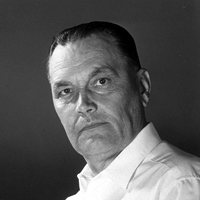Success Starts Here
Your gateway to the Library Catalog, Digital Items, Library Website search results, and more simultaneously!
Your gateway to the Library Catalog, Digital Items, Library Website search results, and more simultaneously!


Paul Salisbury was born in Richfield, Utah in 1903. He was a traditional western painter and illustrator. He died in Provo, Utah in 1973.
Salisbury studied at Brigham Young University with B. F. Larsen; he received private instruction from LeConte Stewart whose tonalist influence can be seen in Salisbury's work. He also studied with his uncle Cornelius Salisbury, a late-nineteenth-century Utah painter.
Salisbury's work appeared in Western Horseman and Desert Magazine. In 1959, an exhibit of his work was held by the Utah State Historical Society. Examples of Salisbury's work are Rider of the Range (1953), Mountain Solitude (1961), and Haystacks (1965).
Biography adapted from Springville Museum of Art.
Western realist Paul Salisbury has achieved more notability as a cowboy/western painter than any other Utah artist of these scenes. His oil paintings represent nature and its inhabitants with subtle realism. Throughout his life, Salisbury was devoted to scenes of the American Indian, the Western cowboy and landscape.
Salisbury's early years were spent on his father's ranch in Richfield, Utah, near the Kanosh Indian Reservation. There he gained a sympathetic awareness and understanding of the western landscape and its inhabitants. During his younger years, he worked for his father on the family ranch, but as often as possible, Paul took off and drew the scenery and animals around him.
Salisbury received formal art training under his uncle, Cornelius Salisbury, who encouraged him in his artistic pursuits. Paul continued his education at Brigham Young University under B. F. Larsen and E. H. Eastman. He also was privately instructed by LeConte Stewart, a noted Utah landscape artist. Despite his early training as an artist, he made a living as a musician and it was not until the early 1950's that Salisbury was able to work continuously as a painter. When he did, he attracted a great deal of attention.
The growing trend during the 1950s and 1960s toward cowboy/western art manifested itself in the paintings of Paul Salisbury of Provo. He was Utah's first significant “Cowboy and Indian“ artist. As one of Utah's very few professional artists, he worked full time on his art and was not affiliated with a university or another occupation, but occasionally taught workshops and classes in painting.
Salisbury's painting, Mountain Solitude, demonstrates that there are no harsh colors in nature. Here, he has rendered the desert valley in muted earth tones and the mountains in gentle blue grays. These delicate colors and the use of short brushstrokes create a soft texture that combine with his treatment of light to enhance the calm atmosphere in the painting.
Salisbury's success as a painter is due in part to his conservative painting style, which is perfectly suited to traditional Utah tastes. Another factor in his success is his ability to create unity in his paintings by using a consistent tonality and bold composition.
Biography courtesy Springville Museum of Art.
Books
Ainsworth, ed. The Cowboy in Art. New York, NY: World Pub. Co, 1968.
Davenport, Ray. Davenport's Art Reference. Ventura, CA: Davenport's Art Reference, 2001.
Dunbier, Lonnie Pierson, ed. The Artists Bluebook: 29,000 North American Artists. Scottsdale, AZ: AskART.com, 2003.
Falk, Peter Hastings. Who Was Who in American Art, 1564-1975: 400 Years of Artists in America. Madison, CT: Sound View Press, 1999.
Falk, Peter Hastings. Who Was Who in American Art : Compiled from the Original Thirty-four Volumes of American Art Annual--Who's Who in Art, Biographies of American Artists Active from 1898-1947. Madison, CT: Sound View Press, 1985.
Olpin, Robert S., William C. Seifrit, and Vern G. Swanson. Artists of Utah. Salt Lake City, UT: Gibbs Smith Publisher, 1999.
Robert E. and Evelyn McKee Foundation. The McKee Collection of paintings. El Paso, TX: El Paso Museum of Art, 1968.
Samuels, Peggy and Harold Samuels. The Illustrated Biographical Encyclopedia of Artists of the American West. Garden City, NY: Doubleday, 1976.
Swanson, Vern G, Robert S. Olpin, and William C. Seifrit. Utah Art. Layton, UT: Peregrine Smith Books, 1992.
Springville Museum of Art. Permanent Collection Catalog. Springville, UT: Springville Museum of Art, 1972.
Swanson, Vern G., Robert S. Olpin, Donna Poulton, and Janie Rogers. 150 Year Survey of Utah Art, Utah Artists. Layton, UT: Gibbs Smith Publisher, 2001.
Swanson, Vern G., Robert S. Olpin, and William C. Seifrit. Utah Painting and Sculpture. Layton, UT: Gibbs Smith Publisher, 1991.
Current News Articles
"Utah Galleries Put On Their Fall Finery And Unveil Blockbuster Exhibitions." The Deseret News, October 7, 1990.
Periodicals
May, Stephen. "Mixing the New and Old." Southwest Art, July 1999.